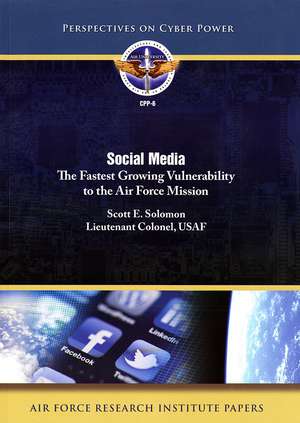Social Media: The Fastest Growing Vulonerability to the Air Force Mission: The Fastest Growing Vulonerability to the Air Force Mission
Editat de Air Force University (U.S.) Autor Scott E. Solomonen Paperback – 23 mar 2017 – vârsta ani
Social
media
is
the
fastest
growing
vulnerability
to
the
military
mission
and
the
personal
security
of
all
Airmen.
On
30
November
2014,
the
FBI
issued
warning
to
members
of
the
US
military
and
requested
that
they
review
their
social
media
presence
for
any
information
like
names
and
addresses
that
might
attract
the
attention
of
violent
ISIS
extremists.
Over the past decade, the convergence of mobile broadband devices has enabled social media to become more and more integrated into our everyday lives. The inherent risks and vulnerabilities of the internet and social networking sites likeFacebook, Instagram, Snapchat, YouTube, LinkedIn, and Twitter, etc.along with the Air Force’s (AF's) endorsement to actively use social media, has cultivated a rich and ripe environment for foreign adversaries and criminals to cherry-pick personal information about Airmen and their missions for nefarious activities.
This text provides some of the most common threats and vulnerabilities of the social media environment, the risks of using social media, recommendations for revising the Air Force current social media guidance and outlines cyberspace best practices. An informed workforce can better protect the Air Force mission and reduce the risk of becoming a target of opportunity.
Audience: Important guidance about potential cyber threats through mobile devices, computer hacking, and social networking are covered within this resource primarily for use by the U.S. Air Force personnel and their families, but may also provide awareness to populations beyond the United States Department of Defense community.
Over the past decade, the convergence of mobile broadband devices has enabled social media to become more and more integrated into our everyday lives. The inherent risks and vulnerabilities of the internet and social networking sites likeFacebook, Instagram, Snapchat, YouTube, LinkedIn, and Twitter, etc.along with the Air Force’s (AF's) endorsement to actively use social media, has cultivated a rich and ripe environment for foreign adversaries and criminals to cherry-pick personal information about Airmen and their missions for nefarious activities.
This text provides some of the most common threats and vulnerabilities of the social media environment, the risks of using social media, recommendations for revising the Air Force current social media guidance and outlines cyberspace best practices. An informed workforce can better protect the Air Force mission and reduce the risk of becoming a target of opportunity.
Audience: Important guidance about potential cyber threats through mobile devices, computer hacking, and social networking are covered within this resource primarily for use by the U.S. Air Force personnel and their families, but may also provide awareness to populations beyond the United States Department of Defense community.
Preț: 76.14 lei
Nou
Puncte Express: 114
Preț estimativ în valută:
14.57€ • 15.10$ • 12.16£
14.57€ • 15.10$ • 12.16£
Carte indisponibilă temporar
Doresc să fiu notificat când acest titlu va fi disponibil:
Se trimite...
Preluare comenzi: 021 569.72.76
Specificații
ISBN-13: 9781585662715
ISBN-10: 1585662712
Pagini: 48
Dimensiuni: 17145 x 235 x 6 mm
Greutate: 0.14 kg
Editura: United States Dept. of Defense
Colecția United States Department of Defense
ISBN-10: 1585662712
Pagini: 48
Dimensiuni: 17145 x 235 x 6 mm
Greutate: 0.14 kg
Editura: United States Dept. of Defense
Colecția United States Department of Defense
Notă biografică
ABOUT
THE
AUTHOR:
Lt Col Scott E. Solomonis assigned to the Air War College, Air University, Maxwell AFB, AL. Colonel Solomon is a career cyberspace operations officer. Born and raised in Southern California, he enlisted in the Air Force in 1988 as a precision measurement equipment laboratory specialist. In 1993, he completed Officer Training School and became a communications and information systems engineering officer. His assignments include various cyberspace, space and airborne operational assignments, and various staff and engineering support positions in six major commands including the Air Staff. In 2006, he served as the joint forces air component commander’s command and control planner directly supporting Operation Iraqi Freedom and Operation Enduring Freedom. He has commanded a squadron and served as a deputy group commander. In his prior assignment, Colonel Solomon was the executive officer to the vice commander, Air Education and Training Command.
Lt Col Scott E. Solomonis assigned to the Air War College, Air University, Maxwell AFB, AL. Colonel Solomon is a career cyberspace operations officer. Born and raised in Southern California, he enlisted in the Air Force in 1988 as a precision measurement equipment laboratory specialist. In 1993, he completed Officer Training School and became a communications and information systems engineering officer. His assignments include various cyberspace, space and airborne operational assignments, and various staff and engineering support positions in six major commands including the Air Staff. In 2006, he served as the joint forces air component commander’s command and control planner directly supporting Operation Iraqi Freedom and Operation Enduring Freedom. He has commanded a squadron and served as a deputy group commander. In his prior assignment, Colonel Solomon was the executive officer to the vice commander, Air Education and Training Command.
Cuprins
Contents
List of Illustrations
About the Author
Abstract
1 The Problem
2 Threats and Vulnerabilities—What Is Different from the Past?
Mobile Device Vulnerabilities
Vulnerabilities of Free Apps
Bring Your Own Device Program
3 Using Social Media—What is the Risk?
Trends in Targeting Personal Information
Data Mining Personal Information
Perceptions of Social Media Risk
4 Air Force Social Media Guidance—What’s Missing?
5 Recommendations
Revise the Air Force Social Media Guidance
Best Practices for Cyberspace Operations
Air Force Smart Cards
6 Conclusion
Acronyms
Appendix
Bibliography
